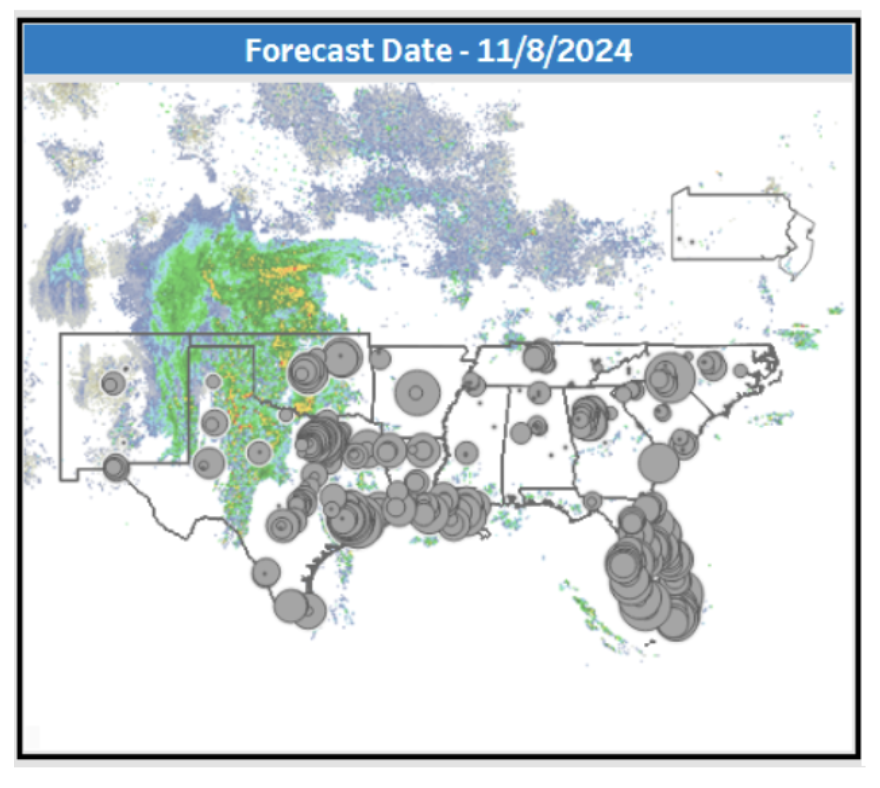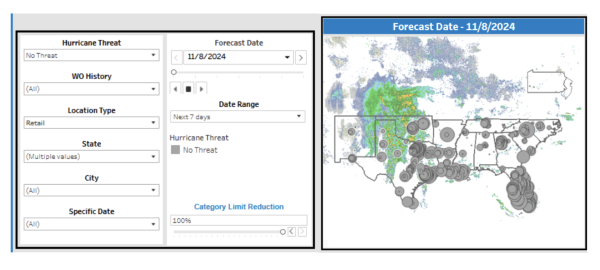
By Maureen Ehrenberg, president, Commercial Division, Lessen — Extreme weather, climate-related physical damage, and catastrophic events have increased in frequency and severity in recent years. Record-breaking heat and cold waves, wildfires, more geographically distributed tornadoes, and widespread flooding from unrelenting rainstorms and hurricanes have impacted families, businesses, and communities globally. These weather events have significant implications for the commercial real estate industry and the way that owners, property and facility managers, tenants,insurers and other stakeholders plan and prepare for risk and resiliency.

Leveraging weather forecast data to identify locations in the path of hurricanes to help clients prepare in advance of the storm and secure their facilities. Courtesy of Lessen
Hurricanes Helene and Milton, which recently devastated many southern states, including Florida and North Carolina, caused billions of dollars of property damage, leaving many real estate owners, managers and tenants scrambling to recover. Rehabbing properties in some areas will take at least 2 years to complete, and some communities will never be the same.
In an environment where severe storms have become the new normal, CRE stakeholders, especially those in high-risk areas, need to take a proactive approach to portfolio health and resiliency and create contingency plans that will enable them to prepare their portfolios for identified risks and respond after an event to implement post-storm recovery as quickly as possible. However, this is a massive undertaking, especially for those with large, distributed portfolios.
As these dynamics persist, technology has emerged as an essential tool helping landlords and occupiers address climate-related challenges. By leveraging intelligent, data-backed solutions, CRE stakeholders can better manage the health, performance, and risk of their portfolios, even in the most dire of conditions.
Building resiliency through tech
In order to create impactful resilience strategies, CRE owners and occupiers must first gain a complete understanding of potential risk at both the portfolio and individual asset levels. Armed with this information, they can create weather and hazard preparedness plans tailored to each property’s individual needs. Tenants should conduct the same type of analysis, understanding their leases, insurance, landlord and tenant impacts and responsibilities in the event of an extreme weather catastrophe.
One way technology aids this process is by providing stakeholders with a picture of potential damages before a weather or hazard event even hits. Using climate technology that can map the specific locations within a portfolio against various potential climate and hazard risks can help identify sites with the most risk and help to understand the potential business impact. Planning and other preparedness measures can also be taken, such as installing an aqua fence.
Let us consider Dollar Mart, a fictional discount retailer with more than a thousand triple net-leased locations across the eastern half of the United States. The company’s real estate team sits in its Atlanta headquarters and oversees the entire portfolio. None of Dollar Mart’s locations — storefronts ranging from 3,000-5,000 square feet — has an onsite property manager; the Atlanta team oversees the physical well-being of the portfolio and taps into each site’s store manager when necessary. Nearly all maintenance work is handled by third-party vendors.
When a hurricane is brewing, there is no on-site staff at any Dollar Mart properties that is knowledgeable about how to prepare for a storm — instead, Dollar Mart’s central real estate and facilities team must grapple with the hurricane’s potential impact across the portion of their portfolio that is likely to be impacted.
In these increasingly common situations, real estate teams are helped immeasurably by data-driven technology that tracks maintenance, repairs, and environmental data, and can highlight properties within a storm’s path and the likelihood that individual properties will face significant damage. Factors like the age of the building and its equipment, roof, type of landscaping — and open work orders — help dictate which properties have the greatest concern within the path of the storm. Technology that helps pinpoint these properties in a massive portfolio can empower real estate and facilities teams to address these items before the storm and/or book third-party vendors to inspect the most vulnerable locations immediately after the hurricane clears, even potentially through the use of drones if access is restricted.
Bouncing back post-storm
While technology is increasingly proving critical for owners and occupiers who strive to be prepared heading into weather events like hurricanes, wildfires, heat and cold waves, etc., a technology framework is just as important for enabling a quick, efficient response post-storm.
Once the storm has passed, Dollar Mart’s real estate team in Atlanta will want to ascertain the level of damage across their portfolio and make repairs to ensure that stores are reopened for business as quickly as possible. In the days after a storm, tools that track facility status and equipment health from a central platform enable the real estate team to address damage across hundreds of properties in real-time. By automating third-party vendor procurement, technology can also help facilitate faster completion of tasks like generator deployment and water intrusion repair, which are critical to reducing business disruption, testing for mold and other environmental issues, and mitigating the costliest property damage.
After the immediate post-storm emergency work is done, Dollar Mart can also use its detailed property data and damage reporting to apply for insurance aid with greater speed and accuracy. Because technology helps the company document and substantiate losses with precision (covering things like pre-storm asset condition, real-time damage reports, and repair actions taken immediately after the event), it helps them significantly strengthen their claims.
Looking ahead
Sadly, the work does not end here, because in high-risk areas, there is always the threat of another storm, weather event or natural hazard — but therein lies another advantage of using technology in facility management.
One of the most compelling benefits of integrating technology into resilience planning is the intel gained before and after damage is repaired. Taking a close look at how properties held up during extreme weather, Dollar Mart can glean actionable takeaways about vulnerabilities exposed during the storm – such as specific equipment failures, weak points in building structure, or areas prone to flooding. With 1,000+ properties in its portfolio, these insights inform long-term improvements to infrastructure across the region and guide preventative measures for future climate-related events.
By continuously keeping the climate mapping current and identifying flood, extreme weather, natural hazards and climate exposures that threaten a company’s assets, risk is being managed as hazards and climate changes and scenarios change over time. Paying close attention to high hazard core assets is also important. Vulnerability and value-at-risk assessments for core assets should be identified to determine which would cause material financial risk to a business in an extreme event. Supply chain risk should also be considered in the planning and mapping. By keeping the risk and resiliency mapping and monitoring current and learning from each storm with the help of technology, CRE owners and occupiers can refine storm and natural hazard response strategies — enhancing property durability, mitigating financial or supply chain risk to the business, and delivering operational efficiency, ultimately building a more resilient portfolio over time.
About the author
 Maureen Ehrenberg, FRICS, CRE, is President of the Commercial Division at Lessen. Formerly CEO and co-founder of Blue Skyre IBE, Ehrenberg is an internationally recognized real estate industry business leader with over 35 years of experience in business process transformation, strategic positioning, and operations of large, complex portfolios. Before co-founding BSI, she was the Global Head of Strategic Real Estate Operations for WeWork.
Maureen Ehrenberg, FRICS, CRE, is President of the Commercial Division at Lessen. Formerly CEO and co-founder of Blue Skyre IBE, Ehrenberg is an internationally recognized real estate industry business leader with over 35 years of experience in business process transformation, strategic positioning, and operations of large, complex portfolios. Before co-founding BSI, she was the Global Head of Strategic Real Estate Operations for WeWork.
Her previous experience also includes being International Director and Global President of JLL’s Facilities Management Services, Global Head of Integrated Facility Management at CBRE, Executive Vice President of Grubb and Ellis Company, and President and CEO of Grubb and Ellis Management Services, Inc. Ehrenberg was named to the 2024 CoreNet Global Distinguished Leaders Circle, is the incoming Senior Vice President of the Royal Institution of Chartered Surveyors, and serves on several industry boards.




